Tuesday, 1st February 2022
Satellite imagery data in policy making
In News
Economic Survey has used a mix of satellite imagery, geospatial data and cartographic techniques to showcase the country's development and urbanisation over the years.
About the News
- Economic survey 2021-22 contains a new approach of tracking development demonstrated by the use of satellite and geo-spatial images to gauge various economic phenomenon such as urbanisation, infrastructure, environmental impact and farming practices, among others.
- Using satellite images, India's night-time luminosity has been compared between 2012 and 2021.
- It provides an interesting representation of the expansion of electricity supply, the geographical distribution of population and economic activity, urban expansion as well as growth of ribbon developments between urban hubs.
- Geospatial and cartographic techniques have been used to show the extent of physical as well as financial infrastructure development in India.
- This includes expansion of national highways, airports, commercial bank branches, metros, etc.
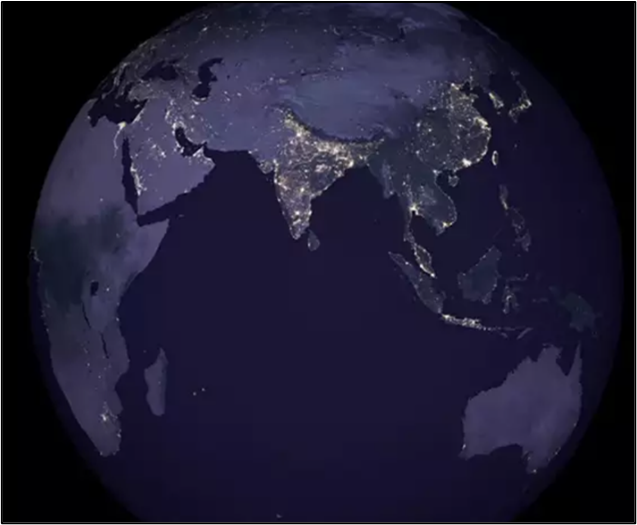
How are satellite images created?
- Various substances and materials such as a standing crop of wheat, a concrete building or a polluted water body reflect light in some parts of the electromagnetic spectrum while absorbing light in others.
- Satellite sensors can detect these differences, some of which are outside the visible light spectrum range, and this data can be synthesized and mapped, sometimes with a lag of a few hours to a few days.
- This data can often not be used in its raw form—it needs to be processed by the end-user to get useful insights.
- NASA Landsat missions, the European Space Agency’s Sentinel missions and Indian Space Research Organisation’s (ISRO) own family of satellites such as Resourcesat are the various remote sensing satellites used for imagery resource monitoring.
How are satellite images used?
- Night-time luminosity maps which show areas of human habitation as brightly-lit specks nable researchers to track the spread of urbanization and human settlement and are essential tools to enable updated estimates of population density over time.
- Land-use maps, which can differentiate between areas of the earth covered by forests, crops and water bodies from those covered by human settlements such as building, helps municipalities track the spread of urbanization and the conversion of agricultural land to urban uses.
- Satellite data can track the progress of crop sowing through the agricultural season over the years as well as areawise, allowing governments to detect and predict a potential slowdown in agricultural growth.
- The data available by satellite imagery can be used in tracking of natural disasters such as flooding. The near real-time availability of satellite data can allow governments, NGOs and volunteers on the ground to track the spread of flooding or wildfires and plan the delivery of relief supplies to affected populations.
- Pollution tracking including air and water pollution, can be done using such images.
- A significant application of the satellite data is to identify locations where crop burning occurs during the winter months—a major source of air pollution in north India.
Sources:
KEY HIGHLIGHTS OF THE ECONOMIC SURVEY 2021-22
In News
Finance Minister tabled the Economic Survey 2021-22 in Parliament ahead of the Union Budget 2022.
The Central Theme of Economic Survey 2021-22
- The central theme of this year’s Economic Survey is the “Agile approach”, implemented through India’s economic response to the COVID-19 Pandemic shock.
- The Survey explains that the “Agile approach” is based on feed-back loops, real-time monitoring of actual outcomes, flexible responses, safety-net buffers and so on.
- The “Agile framework” is particularly relevant today because of the explosion of real-time data that allows for constant monitoring.
- Short-term policy responses, therefore, the Survey states, can be tailored to an evolving situation rather than what a model may have predicted.
- Another theme highlighted in this Economic Survey relates to the art and science of policy-making under conditions of extreme uncertainty. The Survey states that various policies of the Government of India are all about protection from or taking advantage of an uncertain future.
- The Preface also takes a bird’s eye view of the “great deal of evolution” of the Economic Surveys presented since the first Survey in 1950-51. For more than a decade after 1st Survey, the Survey document was clubbed with the Union Budget.
- Making a shift from the two-volume format of recent years the Survey argues for smaller and terse document. Therefore, this year’s Survey reverts to a single volume plus a separate volume for the Statistical Appendix.
- Along with the sectoral chapters, this year's Survey adds a new chapter that demonstrates the use of satellite and geo-spatial images to gauge various economic phenomenons – urbanisation, infrastructure, environmental impact, farming practices and so on.
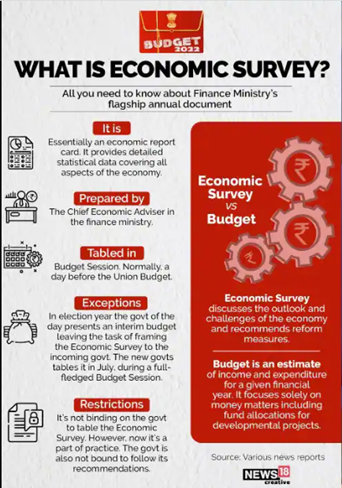
The highlights of the Economic Survey are as follows
- State of the Economy
- Indian economy estimated to grow by 9.2% in real terms in 2021-22 subsequent to a contraction of 7.3 percent in 2020-21. GDP projected to grow by 8- 8.5 percent in real terms in 2022-23.
- On demand side, consumption estimated to grow by 7%, Gross Fixed Capital Formation (GFCF) by 15%, exports by 16.5% and imports by 29.4% in 2021-22.
- Macroeconomic stability indicators suggest that the Indian Economy is well placed to take on the challenges of 2022-23.
- Combination of high foreign exchange reserves, sustained foreign direct investment, and rising export earnings will provide adequate buffer against possible global liquidity tapering.


- Fiscal Developments
- The revenue receipts from the Central Government (April to November, 2021) have gone up by 67.2% (Year-on-Year (YoY)).
- Gross Tax Revenue registered a growth of over 50% during April to November, 2021 in YoY terms. This performance is strong compared to pre-pandemic levels of 2019-2020.
- During April-November 2021, Capex has grown by 13.5% (YoY) with focus on infrastructure-intensive sectors.
- The fiscal deficit for April to November, 2021 stood at 46.2% of Budget Estimate (BE).
- With the enhanced borrowings on account of COVID-19, the Central Government debt has gone up from 49.1% of GDP in 2019-20 to 59.3% of GDP in 2020-21, but is expected to follow a declining trajectory with the recovery of the economy.

- External Sectors
- India’s merchandise exports and imports rebounded strongly and surpassed pre-COVID levels.
- There was significant pickup in net services with both receipts and payments crossing the pre-pandemic levels, despite weak tourism revenues.
- India’s external debt rose to US $ 593.1 billion at end-September 2021, from US $ 556.8 billion a year earlier, reflecting additional SDR allocation by IMF, coupled with higher commercial borrowings.
- As of end-November 2021, India was the fourth largest forex reserves holder in the world after China, Japan and Switzerland.
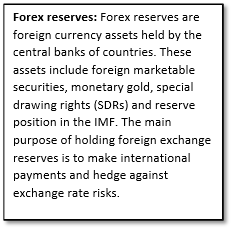
- Monetary Management and Financial Intermediation
- The liquidity in the system remained in surplus. RBI undertook various measures such as G-Sec Acquisition Programme and Special Long-Term Repo Operations to provide further liquidity.
- The Gross Non-Performing Advances ratio of Scheduled Commercial Banks (SCBs) declined from 11.2% at the end of 2017-18 to 6.9% at the end of September, 2021.
- Capital to risk-weighted asset ratio of SCBs continued to increase from 13% in 2013-14 to 16.54% at the end of September 2021.
- Exceptional year for the capital markets: 89,066 crore was raised via 75 Initial Public Offering (IPO) issues in April-November 2021, which is much higher than in any year in the last decade.
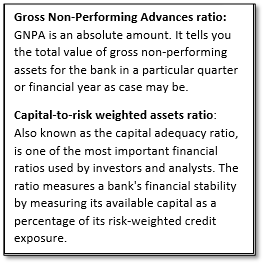
- Prices and Inflation
- The average headline CPI-Combined inflation moderated to 5.2% in 2021-22 (April-December).
- The decline in retail inflation was led by easing of food inflation. Reduction in central excise and subsequent cuts in Value Added Tax by most States helped ease petrol and diesel prices.
- Wholesale inflation based on Wholesale Price Index (WPI) rose to 12.5% during 2021-22.
- This has been attributed to: Low base in the previous year, Pick-up in economic activity, Sharp increase in international prices of crude oil and other imported inputs, and High freight costs.
- Divergence between CPI-C and WPI Inflation: This can be explained by factors such as: Variations due to base effect, Difference in scope and coverage of the two indices, Price collections, Items covered, Difference in commodity weights, and WPI being more sensitive to cost-push inflation led by imported inputs.

- Sustainable Development and Climate Change
- India’s overall score on the NITI Aayog SDG India Index and Dashboard improved to 66 in 2020-21 from 60 in 2019-20 and 57 in 2018-19.
- India has the tenth largest forest area in the world. In 2020, India ranked third globally in increasing its forest area during 2010 to 2020.
- In August 2021, the Plastic Waste Management Amendment Rules, 2021, was notified which is aimed at phasing out single use plastic by 2022.
- Draft regulation on Extended Producer Responsibility for plastic packaging was notified.
- The Prime Minister, at COP 26 in Glasgow, announced ambitious targets to be achieved by 2030 to enable further reduction in emissions. The need to start the one-word movement ‘LIFE’ (Lifestyle for Environment) urging mindful and deliberate utilization instead of mindless and destructive consumption was underlined.
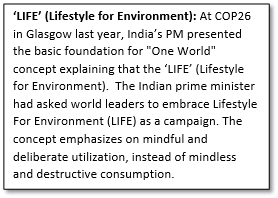
- Agriculture and Food Management
- The Agriculture sector experienced buoyant growth in past two years, accounting for 8% (2021-22) in Gross Value Added (GVA) of the country.
- Minimum Support Price (MSP) policy is being used to promote crop diversification.
- Net receipts from crop production have increased by 22.6% in the latest Situation Assessment Survey (SAS) compared to SAS Report of 2014.
- Allied sectors including animal husbandry, dairying and fisheries are steadily emerging to be high growth sectors and major drivers of overall growth in agriculture sector.
- The Livestock sector has grown at a CAGR of 8.15% over the last five years ending 2019-20. It accounts for about 15% of average monthly income of agricultural households.

- Industry and Infrastructure
- Index of Industrial Production (IIP) grew at 17.4% (YoY) during April-November 2021.
- Capital expenditure for the Indian railways has increased to Rs. 155,181 crores in 2020-21 and it has been budgeted to increase to Rs. 215,058 crores in 2021-22 –5 times increase from 2014 level.
- Extent of road construction per day increased substantially in 2020-21 to 36.5 Kms per day from 28 Kms per day in 2019-20.
- Introduction of Production Linked Incentive (PLI) scheme, major boost provided to infrastructure-both physical as well as digital, along with measures to reduce transaction costs and improve ease of doing business, would support the pace of recovery.
- Services
- GVA of services crossed pre-pandemic level in July-September quarter of 2021-22; however, GVA of contact intensive sectors like trade, transport, etc. still remain below pre-pandemic level.
- During the first half of 2021-22, service sector received over US$ 16.7 billion FDI – accounting for almost 54% of total FDI inflows into India.
- Services exports surpassed pre-pandemic level in January-March quarter of 2020-21 and grew by 21.6 percent in the first half of 2021-22 - strengthened by global demand for software and IT services exports.
- India has become 3rdlargest start-up ecosystem in the world after US and China. Number of new recognized start-ups increased to over 14000 in 2021-22 from 733 in 2016-17.
- 44 Indian start-ups have achieved unicorn status in 2021 taking overall tally of unicorns to 83, most of which are in services sector.
- Social Infrastructure and Employment
- 94 crore doses of COVID-19 vaccines administered as on 16thJanuary 2022; 91.39 crore first dose and 66.05 crore second dose.
- As per the quarterly Periodic Labour Force Survey (PFLS) data up to March 2021, employment in urban sector affected by pandemic has recovered almost to the pre-pandemic level.
- According to Employees Provident Fund Organisation (EPFO) data, formalization of jobs continued during second COVID wave.
- Expenditure on social services (health, education and others) by Centre and States as a proportion of GDP increased from 6.2 % in 2014-15 to 8.6% in 2021-22 (BE).
- As per the National Family Health Survey-5:
- Total Fertility Rate (TFR) came down to 2 in 2019-21 from 2.2 in 2015-16
- Infant Mortality Rate (IMR), under-five mortality rate and institutional births have improved in 2019-21 over year 2015-16
- Under Jal Jeevan Mission (JJM), 83 districts have become ‘Har Ghar Jal’ districts.
- Increased allotment of funds to Mahatma Gandhi National Rural Employment Guarantee Scheme (MNREGS) to provide buffer for unorganized labour in rural areas during the pandemic.
Question: Discuss the major findings of the economic Survey related to the sustainable development and agriculture.
Sources:
- KEY HIGHLIGHTS OF THE ECONOMIC SURVEY 2021-22
- CENTRAL THEME OF ECONOMIC SURVEY 2021-22 IS THE “AGILE APPROACH”
- SUMMARY OF THE ECONOMIC SURVEY 2021-22
- Economic Survey 2022 | Here are the key highlights from the survey
- How to Calculate the Capital-To-Risk Weighted Assets Ratio:
- INDIA'S ECONOMY DASHBOARD
- Check the financial health of your bank with these 8 ratios:
- From 'Lifestyle for Environment' to 'net zero carbon emissions by 2070': Key takeaways from Narendra Modi's historic COP26 speech
- What Is an Initial Public Offering (IPO)?:
- PM Modi on climate: what is 'Lifestyle for Environment'?:
- The Hindu Explains | What is Gross Value Added, and how is it relevant when growth is announced in GDP terms?:
- Gross Value Added (GVA):
- Definition of 'Fiscal Deficit':
- Economic Survey 2022: India needs to invest $1.4 trillion by 2024-25 on infrastructure to achieve $5 trillion GDP:
- What is CAGR:
A hazy picture on employment in India: TH
Essence: The article focuses on the two important indicators of structural transformation in any economy, which are the rates of growth and changes in the structural composition of output and the workforce. Changes in contribution of different sectors of economy in economic growth has not been followed by a simultaneous change in their contribution in employment.
Analysis of employment data from PLFS contradicts many earlier findings like on worker to population ratio and female labor force participation. Because of increasing use of labor-displacing technologies in manufacturing and services, the majority of the new entrants to the labor force between 2017-18 and 2019-20 had to be absorbed in the agriculture sector. Author suggests that it is time to shift focus from industry-led growth to an agri-centric model of economic transformation to create more satisfying employment in the agri sector.
Why should you read this article?
- To understand the mismatch between structural transformation happening in economic growth and employment generation.
- To understand some important findings of the Periodic Labor Force Participation survey (PLFS).
Source:
Afghanistan Pakistan Relations and the Durand Line: ORF
Essence: The editorial talks about one of the primary bone of contention between India’s neighbors- Pakistan and Afghanistan boundary issue. The Durand line was marked by the British to extend a sphere of influence and mark it as buffer region, since it couldn’t formally capture the tribal dominated areas of Afghanistan and it feared the looming attacks by USSR. Since the formation of Pakistan as an independent nation, it has started to extend the boundary and encroach into Afghanistan’s territory. On the other hand, Taliban and previous governments in Afghanistan have clearly objected to the erstwhile boundary marking since it separates the Pashtun tribes between two countries. Successive governments in Afghanistan, therefore, have not accepted the Durand line.
Gaining legitimacy in international community for Taliban is the key to ending humanitarian crisis in the nation but Pakistan’s support is essential for this cause. In this context, the Durand line crisis tests the relationship that both neighbors share with each other.
Why you should read this article?
- To understand the history of Durand line.
- To know the stand of Afghanistan and why it doesn’t support Durand line agreement.
Source:
How India can adapt to global geoeconomic churn: IE
Essence: The article focuses on India’s path in the geo-economic churning that the world is currently going through. India's geopolitical importance in the world will continue to climb as it returns to a high growth path and is now placed as the world's sixth largest economy. However, the transition from three to eight trillion dollars in GDP will not be smooth; nor will it be easy to protect India's interests as the country becomes more integrated with the rest of the globe. This will necessitate India's adaptability to significant changes in the global economic system. First, addressing the increasing agreement on the increased role of economics in global affairs, as opposed to the supremacy of military competition during the Cold War years. It implies that, Economics will not take the place of politics in the international order but can make a stronger case for the connection between geopolitics and geoeconomics. Although India's choice to abandon Asian economic cooperation and selective trade agreements and efforts to boost indigenous manufacturing has been widely criticized as a risky retreat to economic protectionism and deglobalization. Those arguments must continue, but they must be more directly linked to structural changes in the international economic order. Above all, India need a strategy that can address the imperatives of strengthening internal capabilities, forging geoeconomic partnerships, and forming geopolitical alliances with like-minded nations.
Why should you read this article?
- To comprehend why the trip from three to eight trillion dollars will not be a straight line.
- To learn about the initiatives that could be made to integrate the financial, commercial, technical, security, and foreign policies of the country.
Source:
Share the article
Get Latest Updates on Offers, Event dates, and free Mentorship sessions.

Get in touch with our Expert Academic Counsellors 👋
FAQs
UPSC Daily Current Affairs focuses on learning current events on a daily basis. An aspirant needs to study regular and updated information about current events, news, and relevant topics that are important for UPSC aspirants. It covers national and international affairs, government policies, socio-economic issues, science and technology advancements, and more.
UPSC Daily Current Affairs provides aspirants with a concise and comprehensive overview of the latest happenings and developments across various fields. It helps aspirants stay updated with current affairs and provides them with valuable insights and analysis, which are essential for answering questions in the UPSC examinations. It enhances their knowledge, analytical skills, and ability to connect current affairs with the UPSC syllabus.
UPSC Daily Current Affairs covers a wide range of topics, including politics, economics, science and technology, environment, social issues, governance, international relations, and more. It offers news summaries, in-depth analyses, editorials, opinion pieces, and relevant study materials. It also provides practice questions and quizzes to help aspirants test their understanding of current affairs.
Edukemy's UPSC Daily Current Affairs can be accessed through:
- UPSC Daily Current Affairs can be accessed through Current Affairs tab at the top of the Main Page of Edukemy.
- Edukemy Mobile app: The Daily Current Affairs can also be access through Edukemy Mobile App.
- Social media: Follow Edukemy’s official social media accounts or pages that provide UPSC Daily Current Affairs updates, including Facebook, Twitter, or Telegram channels.





